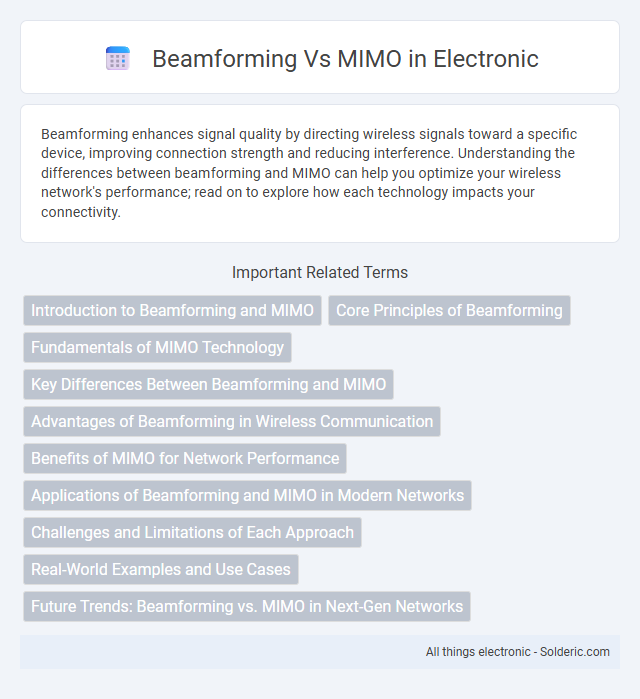Beamforming enhances signal quality by directing wireless signals toward a specific device, improving connection strength and reducing interference. Understanding the differences between beamforming and MIMO can help you optimize your wireless network's performance; read on to explore how each technology impacts your connectivity.
Comparison Table
| Feature | Beamforming | MIMO (Multiple Input Multiple Output) |
|---|---|---|
| Definition | Signal processing technique focusing radio signals in specific directions. | Technology using multiple antennas for simultaneous data transmission and reception. |
| Main Purpose | Enhance signal strength and reduce interference. | Increase data throughput and spectral efficiency. |
| Operation | Directs transmission and reception beams towards targeted users. | Utilizes multiple spatial streams to transmit parallel data streams. |
| Complexity | Moderate signal processing requirements. | Requires advanced signal processing and antenna coordination. |
| Use Cases | Improving signal quality in wireless communication (Wi-Fi, 5G, LTE). | Boosting network capacity and throughput in wireless systems. |
| Benefits | Improved coverage, reduced interference, energy efficiency. | Higher data rates, better reliability, enhanced spectral efficiency. |
| Typical Technologies | 5G NR, Wi-Fi 6 (802.11ax), LTE Advanced. | 5G NR, LTE Advanced, Wi-Fi 6, Massive MIMO systems. |
Introduction to Beamforming and MIMO
Beamforming is a signal processing technique that directs wireless signals toward a specific receiving device, enhancing signal strength and reducing interference in your network. MIMO (Multiple Input Multiple Output) uses multiple antennas at both the transmitter and receiver to send and receive more data simultaneously, significantly increasing throughput and reliability. Together, beamforming and MIMO optimize wireless communication by improving coverage, capacity, and overall network performance.
Core Principles of Beamforming
Beamforming enhances wireless communication by directing signals towards specific receivers using antenna arrays to improve signal strength and reduce interference. This technique leverages constructive and destructive interference patterns to focus the transmission or reception of radio waves. Core principles include spatial filtering, phase shifting, and adaptive beam steering, enabling increased network capacity and reliability compared to conventional broad-spectrum transmission methods.
Fundamentals of MIMO Technology
MIMO technology leverages multiple antennas at both the transmitter and receiver to enhance data throughput and signal reliability by exploiting spatial multiplexing and diversity gains. Unlike beamforming, which directs a focused signal beam toward a specific user or direction to improve signal strength, MIMO simultaneously transmits multiple independent data streams over the same frequency band. Your wireless network performance significantly improves with MIMO's ability to handle multipath propagation, increasing spectral efficiency and robustness in complex environments.
Key Differences Between Beamforming and MIMO
Beamforming enhances signal strength and coverage by directing wireless signals to specific devices using multiple antennas, optimizing the transmission path for improved reception. MIMO (Multiple Input Multiple Output) increases data throughput and network capacity by utilizing multiple antennas at both the transmitter and receiver to send and receive several data streams simultaneously. While beamforming focuses on signal directionality for better range and quality, MIMO emphasizes parallel data transmission to boost overall channel efficiency and speed.
Advantages of Beamforming in Wireless Communication
Beamforming enhances wireless communication by directing signals toward specific users, resulting in improved signal strength and reduced interference. This targeted approach increases network capacity and extends coverage range, making it ideal for high-density environments. Your wireless experience benefits from more reliable connections and higher data rates due to the focused energy transmission of beamforming compared to traditional MIMO systems.
Benefits of MIMO for Network Performance
MIMO technology significantly enhances network performance by utilizing multiple antennas to transmit and receive data simultaneously, increasing throughput and spectral efficiency. This spatial multiplexing enables higher data rates and improved signal reliability, reducing latency and mitigating interference. As a result, MIMO supports greater network capacity and better coverage compared to traditional beamforming techniques.
Applications of Beamforming and MIMO in Modern Networks
Beamforming enhances signal strength and network capacity by directing wireless signals toward specific users, making it essential in 5G networks, Wi-Fi 6, and smart antenna systems for improved coverage and reduced interference. MIMO technology, using multiple transmitters and receivers, significantly increases data throughput and reliability, widely applied in LTE, 5G NR, and advanced Wi-Fi standards for handling high user density and complex environments. Both beamforming and MIMO are critical in modern network infrastructure, enabling efficient spectrum utilization and supporting high-speed, low-latency communication required for IoT, autonomous vehicles, and augmented reality applications.
Challenges and Limitations of Each Approach
Beamforming faces challenges related to hardware complexity and precise channel state information requirements, limiting its scalability in dense network environments. MIMO struggles with signal interference, increased computational load for multi-user detection, and higher energy consumption, which can impact overall system efficiency. Both techniques require sophisticated algorithms and face trade-offs between performance gains and implementation costs in real-world wireless communication systems.
Real-World Examples and Use Cases
Beamforming is widely used in 5G networks to enhance signal quality and extend coverage in urban environments by directing radio waves toward specific users, improving connection reliability in crowded areas like stadiums and airports. MIMO technology underpins Wi-Fi 6 routers, enabling multiple data streams to be transmitted simultaneously, resulting in higher throughput and better performance for devices in homes and offices with numerous connected users. Your choice between beamforming and MIMO depends on the need for targeted signal enhancement or maximizing network capacity in scenarios such as mobile broadband or dense indoor networks.
Future Trends: Beamforming vs. MIMO in Next-Gen Networks
Future trends in next-gen networks highlight beamforming's role in enhancing signal directionality and reducing interference, optimizing user experience. MIMO technology focuses on increasing data throughput and spectral efficiency by utilizing multiple antennas for simultaneous transmission and reception. Your network deployment strategy will benefit from integrating both, leveraging beamforming's precision and MIMO's capacity to meet growing connectivity demands.
beamforming vs MIMO Infographic

 solderic.com
solderic.com